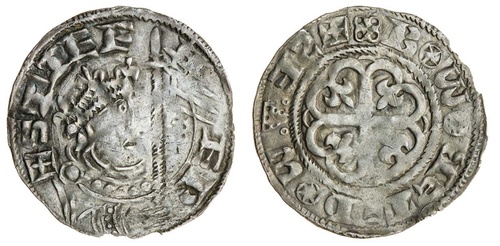
Auction: 18048 - The Williams Collection Part III - Norman Coins
Lot: 442
(x) Stephen (1135-54), Penny, 0.97g, local and irregular issues of the Civil War, Flag / Ornaments type, York, +
Purchased from Spink, October 1991
It was at the end of the 19th century that A E Packe suggested that the the flag which replaces the sceptre on the obverse of these coins represents the standard erected, under the directions of Archbishop Thurstan, on the battlefield at Northallerton when a Yorkshire army defeated a Scottish invasion force under king David (the 'Battle of the Standard'), in 1138. (A E Packe, 'The Coins of Stephen' in NC 3rd series. 16 (1896), 68, and others)
Nearly 100 years later, Peter Seaby suggested the banner represents the papal standard presented to Stephen at the time of the Second Crusade in 1147. (P Seaby, 'A new 'Standard' type for the reign of king Stephen' in BNJ 53 (1983) pp.14-18).
More recently George Boon pointed out that the equestrian figure of the king on the reverse of the Second Great Seal of Stephen (in use after 1141), also depicts the king carrying a streaming standard, instead of the usual sword.
The letters and symbols on the reverse have not been fully interpreted. A few reverse dies appear to show a literate mint signature
There are at least 40 Pennies and 10 cut halfpennies of the type known, and the letters and symbols vary considerably. The 23 Pennies listed in detail by Allen (NC 2006, pp. 304-306), are struck from 20 different pairs of dies, suggesting that surviving examples are only a small representation of a prolific coinage and supporting Blackburn's conclusion that the flag type was the principle York coinage of the second half of the 1140s.
Subject to 5% tax on Hammer Price in addition to 20% VAT on Buyer’s Premium. For more information please view Terms and Conditions for Buyers.
Sold for
£2,200




